 Puro Pro comes in an attractive bamboo box with brass clasp, reminiscent of a good cigar box.Jim Salter
Puro Pro comes in an attractive bamboo box with brass clasp, reminiscent of a good cigar box.Jim Salter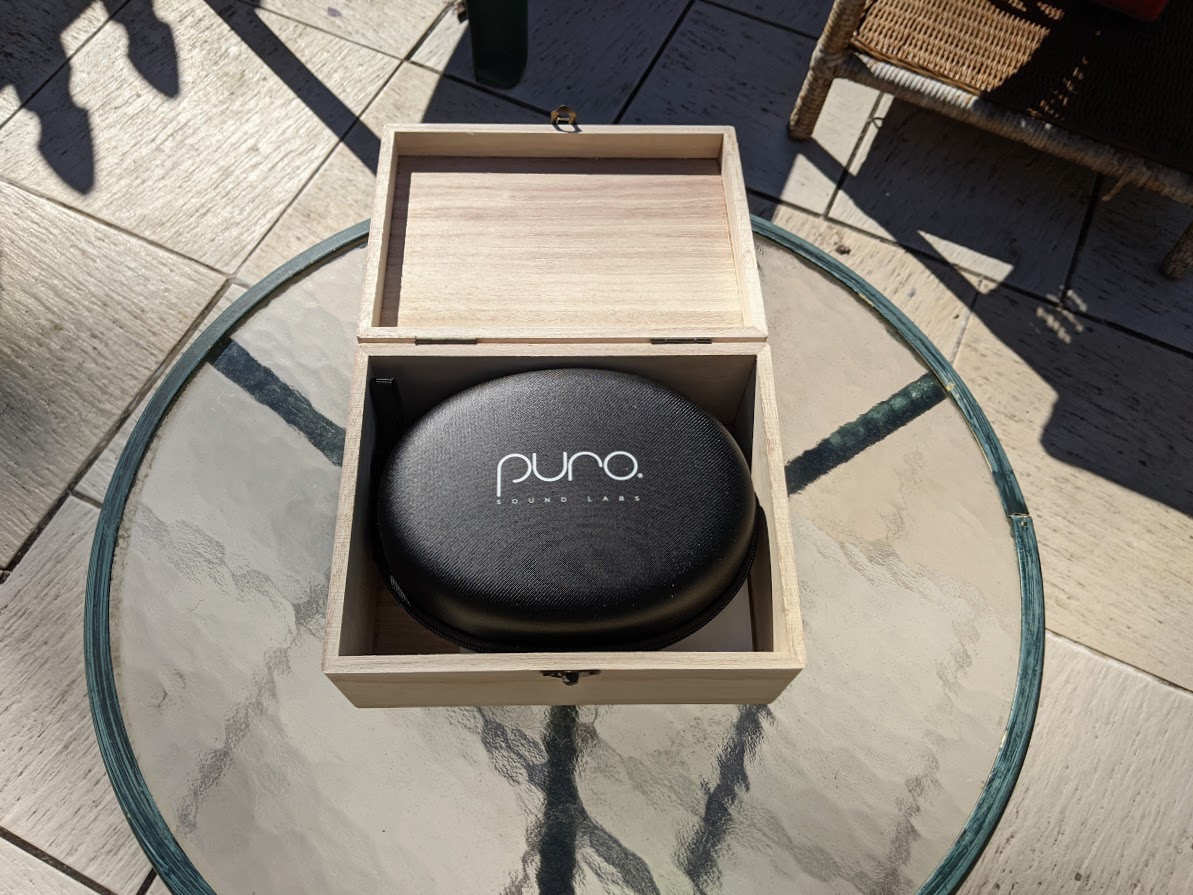 Inside the display box, the headphones and cables are packed in a posh travel case, which will keep things organized and undamaged when you cram the whole thing in a backpack like the techno-troglodyte you are.Jim Salter
Inside the display box, the headphones and cables are packed in a posh travel case, which will keep things organized and undamaged when you cram the whole thing in a backpack like the techno-troglodyte you are.Jim Salter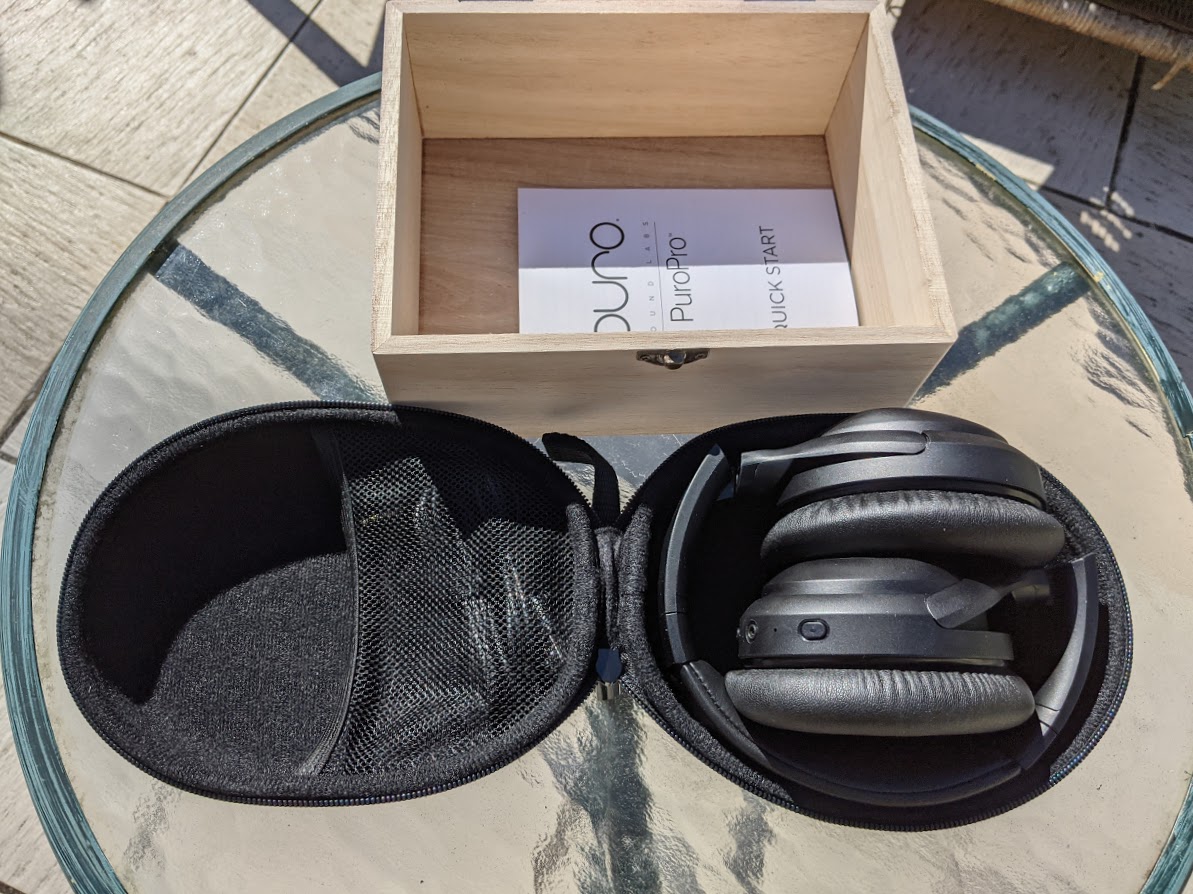 The travel case has a netted section sufficient to hold the (included) USB Micro-B charge cable and 3.5mm audio cable and maybe a USB thumb drive or two if necessary.Jim Salter
The travel case has a netted section sufficient to hold the (included) USB Micro-B charge cable and 3.5mm audio cable and maybe a USB thumb drive or two if necessary.Jim Salter These violas are enjoying high-quality streaming audio from YouTube music. Also, they're holding up the phones so you can see the Puro logo on the top, which is their only visible branding.Jim Salter
These violas are enjoying high-quality streaming audio from YouTube music. Also, they're holding up the phones so you can see the Puro logo on the top, which is their only visible branding.Jim Salter
Last December, a representative for Puro Sound Labs offered me a review sample of the company's flagship Bluetooth hybrid headphones. Her timing couldn't have been better—I had surgery scheduled for January 8 that would put me on the couch all day, every day, for two weeks straight with nothing to do but watch movies and television (ideally without driving my wife and kids insane).
The Puro Pro is an over-the-ear design, which can be connected to audio sources via Bluetooth 5.0 pairing or a simple headphone cord. It offers just about any feature you might dream up for a pair of headphones: safety volume limiting (configurable for either 85dBA or 95dBA), 30+ hour battery life, content control via buttons on the left can, active noise cancellation, and even an inline mic for phone calls.
At $200, the Puro Pro costs more than I'd normally spend on a pair of headphones for watching late-night TV and flying on the occasional airplane (my two primary use cases). But after spending several hours per day with the Puro Pro for a couple of months, I would drop the cash in a heartbeat.
How I tested
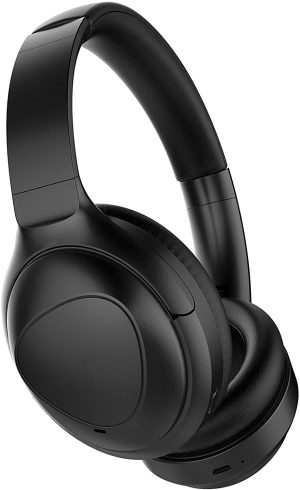
Puro Sound Labs PuroPro Hybrid Active Noise Cancelling Headphones
This setup was my most important test scenario for the headphones, but I also gave them more demanding tests of musical accuracy by connecting them (wired) to the Scarlett Solo preamp I use in my podcasting studio. The Scarlett Solo is connected to my workstation; its major "work" function is providing an XLR input for my RE230 mic, but it does double duty as my system's main audio output interface, via its 1/4" headphone jack—normally connected to a pair of Sennheiser HD 280 Pro studio headphones.
I should be very clear that my testing is subjective—I actually used the headphones and compared them to several sets of reference gear, and I'm sharing my impressions here. With that said, I'm a fairly demanding listener; I grew up with a broadcast engineer for a dad, and I've spent the last 30 years trying to buy personal audio equipment that straddles the line between "this is some of the best you can buy" and "this is wallet-draining audiophile nonsense."
The competition
I'm a night owl, but my wife is an early riser, so quiet late-night movie and TV watching is essential at the Salter household. Wireless earbuds turned out to be a no-go for me. I tried several models that I liked the sound of, but—while I found them comfortable initially—all led to repeated ear infections after long-term, daily use. Battery life was also less than ideal—the LG Tone HBS-510 earbuds I used the most only got about eight to 10 hours of play time, with similar results for a variety of lesser-known brands.
Next, I tried a set of Monodeal on-ear Bluetooth headphones—at $35, they're an incredible value, and I ended up getting a second pair for my wife (who also loved them). But I still had comfort issues; after several TV episodes in a row, the on-ear design would get a bit ouchy. The battery life also left something to be desired, at around eight hours—not bad for the price, but not long enough to get you through cross-continent plane trips without careful husbanding.
Finally, I used a $200 pair of JBL Live 650BTNC over-the-ear Bluetooth headphones. Their over-the-ear design was far more comfortable for long-term use than the Monodeal pair, and the playtime of 20+ hours was a huge improvement. The audio quality was also a little better than the Monodeal. They still weren't 100 percent comfortable for long-term use, though, due to weight, balance issues, and the combination of very firm padding and significant clamping pressure on my head.
Although the JBL headphones weren't perfect, they were workable enough that I wasn't really in the market for a replacement.
Evaluating Puro Pro
For my major use case—watching TV and movies late at night on the couch without disturbing my wife—the Puro Pro headphones are far and away the best thing I've tried. I also found them excellent for listening to a wide variety of musical genres, including classical, acoustic, a capella, and hip-hop.
The only flaw I could find with them—aside from the charge port not being USB-C—is an annoying background buzz artifact produced when the headphone volume is at max and a staccato sound (for example, the "click" when moving focus on the Roku interface from one item to another) is produced. That flaw is easily worked around: just turn the headphone volume down a single click and no more buzz.
Comfort
The padding is extremely soft and comfortable, and the headphones provide just enough clamping pressure to stay firm without getting ouchy after a few hours.
Although the weight of the JBL and Puro headphones is similar, the balance is different. This isn't something I notice instantly when putting either set of headphones on—but after several hour-long episodes of a binged show (or one Lord of the Rings movie), the JBL phones leave my neck feeling a little strained, while the Puro Pro phones do not.
The lighter clamping pressure and softer padding on the Puro Pro headphones also leaves me with significantly less "sweaty ear" feeling after several hours of extended use than I got from the JBL headphones—or, for that matter, from my Sennheiser HD 280 Pro studio phones after recording a podcast.
Controls
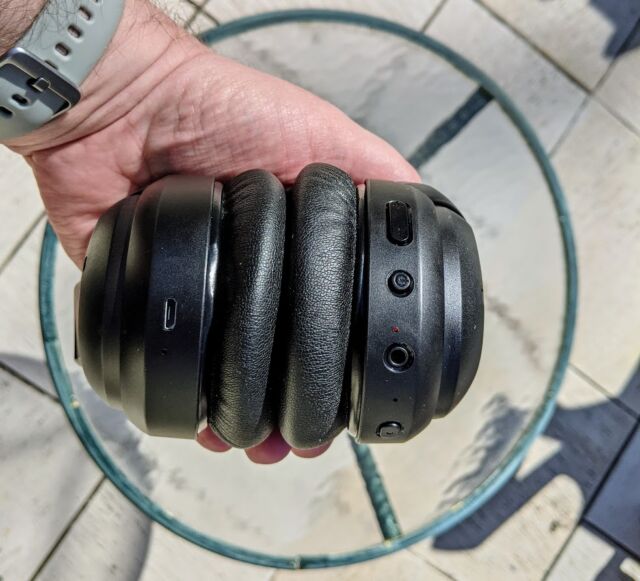
The charging port for the Puro Pro is on the left can. Unfortunately, it's USB Micro-B and not USB-C, so it's afflicted with the familiar "is it right side up or not?" fandango when charging the phones.
All the buttons you need on the Puro Pro are on the right can, and they're easy to distinguish by feel alone—a minor issue I had with both the Monodeal and JBL headphones. Although there are technically two volume buttons, they're covered by a single wide plastic cap, making them a sort of faux rocker switch.
The next button beneath the volume "rocker" is the power button. Continuing to travel clockwise around your right ear toward the back of your head, the next thing up is the 3.5mm audio jack. On the other side of that is the final button, which controls Active Noise Cancellation.
After six months of daily use with the JBL headphones, I still struggled to remember which button was which by feel—all the buttons were the same small, round shape, so you just had to know by heart what order they came in. By contrast, the single long cap on the volume buttons on Puro Pro serves as a tactile anchor you can recognize without needing to press and see what happens. I felt familiar with and confident of the Puro Pro's button placement after only a day or two of use.
Another thing I appreciated about the Puro Pro was the lack of buttons that I didn't need. The JBL headphones include built-in Alexa assistant functionality, which I neither need, want, nor even ever learned how to use... but it was activated by pressing the entire side of either the left or right can toward your head, which is obnoxiously easy to accidentally trigger. If you do, a voice drones "Alexa function not configured" over your media.
After two months of daily use, I have yet to accidentally trigger a control on the Puro Pro.
Power and pairing
A short press of the Puro Pro's power button won't do anything at all—you'll need a two-second-long press to turn it on. At two seconds, a pleasant female voice announces, "power on," and you can let go. Shortly afterward, the voice announces, "battery high/middle/low" as appropriate; a second or so later (assuming the phones are paired to a present source), the voice announces "connected" and audio begins to play.
To turn the Puro Pro off, you'll need another, even longer press. At two seconds, a short "beep" sounds in the headphones—but this is just a warning that you're about to turn them off; you'll need to hold the button down for another second before hearing the female voice announce "powering off," at which point you can release the button.
To pair the Puro Pro headphones with a Bluetooth source, you need another very long press—about five seconds, at which point the tiny status LED next to the button begins flashing a rapid red/blue sequence. At this point, the Puro Pro will show up as available to any audio source that lets you pick from a list. Screen-less sources, like my Boltune Bluetooth transceiver, should automatically pair once both are in their search sequences.
Active Noise Cancellation
Active Noise Cancellation on the Puro Pro effectively kills off repetitive droning, murmuring, or rattling sounds, though it does little to muffle anything else (for example, unwanted nearby conversations). Pressing the ANC button toggles between ANC1, ANC2, and off; the female voice announces each condition as you toggle through.
When ANC is triggered in a noisy environment—in the middle of a crowd, in the presence of a rattling air conditioner register, in a vehicle on rough road—there's a significant, even startling reduction in the volume of the background noise. When triggered in a quiet environment, ANC just produces a low but audible pink-noise equivalent. I could detect no difference whatsoever between ANC1 (15 dB reduction) and ANC2 (32dB reduction)—both seemed to cut the background noise equally.
I didn't find ANC in the Puro Pro to be different than in other headphones—including the Monodeal on-ear phones, the JBL over-ear phones, or several varieties of inexpensive Bluetooth earbuds—that I've tried. They all work well in noisy environments, they all produce a noticeable pink-noise hiss in quiet environments, and none really stands out more than the others.
The only significant factor in any of the ANC-enabled devices I've tested isn't the active noise cancellation itself; it's how much simple audio isolation the phones themselves provide in addition to the ANC. The Puro Pros come in toward the high end of the pack; they're not quite as deadening as the deeper, more stiffly padded cans on the JBL phones or the Sennheisers—but they provide significantly more isolation than the on-ear Monodeal phones.
Comparing them to ANC-enabled earbuds is more of a mixed bag—in-ear phones do a better job of isolating high-frequency noises, but over-the-ear cans like the Puro Pros do a somewhat better job of isolating midfrequency noise.
Volume safety limiting
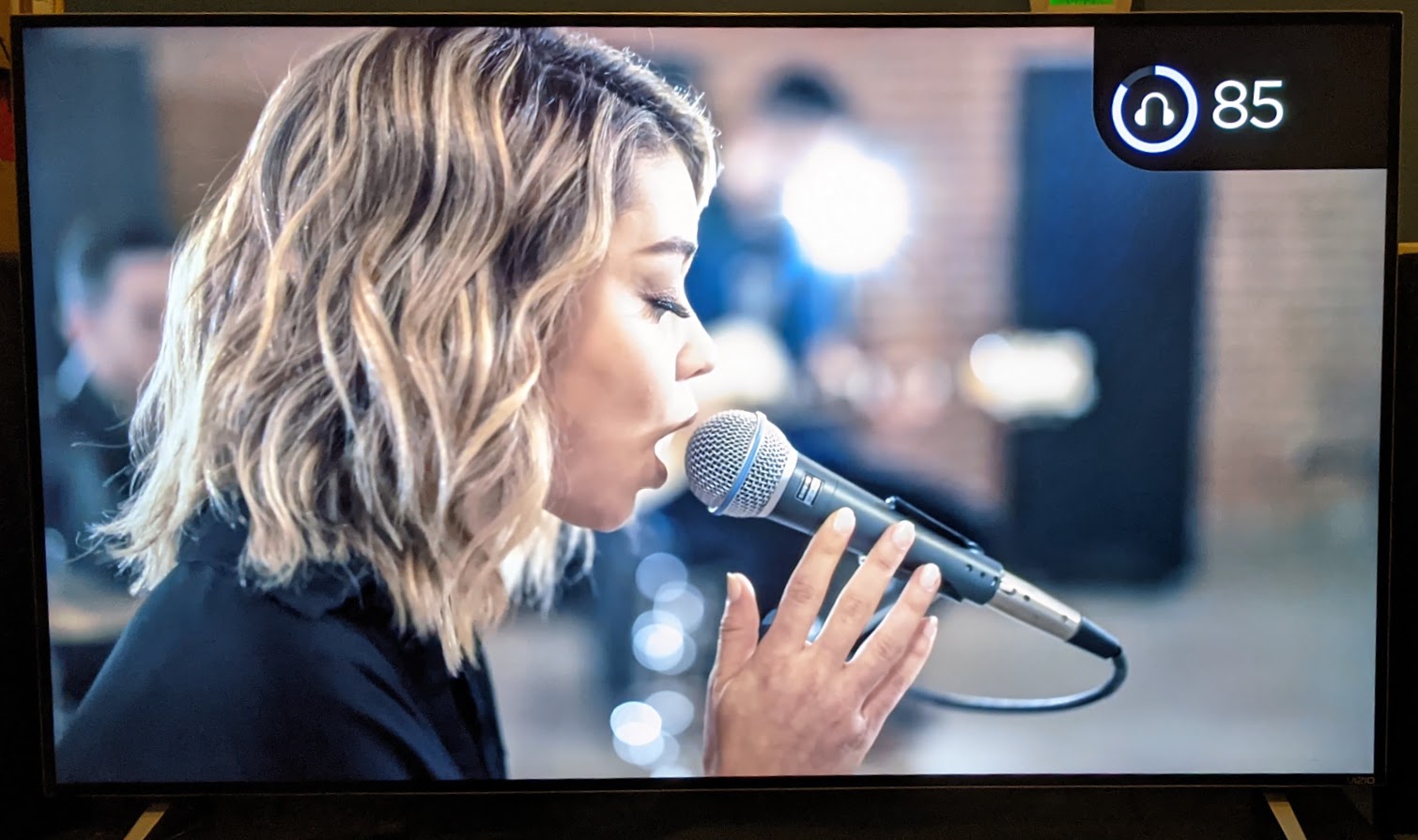 With Puro Pro volume at maximum and Roku source volume at 85, audio was loud but comfortable and undistorted. Increasing volume from here didn't make things louder, but it produced increasingly nasty square-wave distortion.Jim Salter
With Puro Pro volume at maximum and Roku source volume at 85, audio was loud but comfortable and undistorted. Increasing volume from here didn't make things louder, but it produced increasingly nasty square-wave distortion.Jim Salter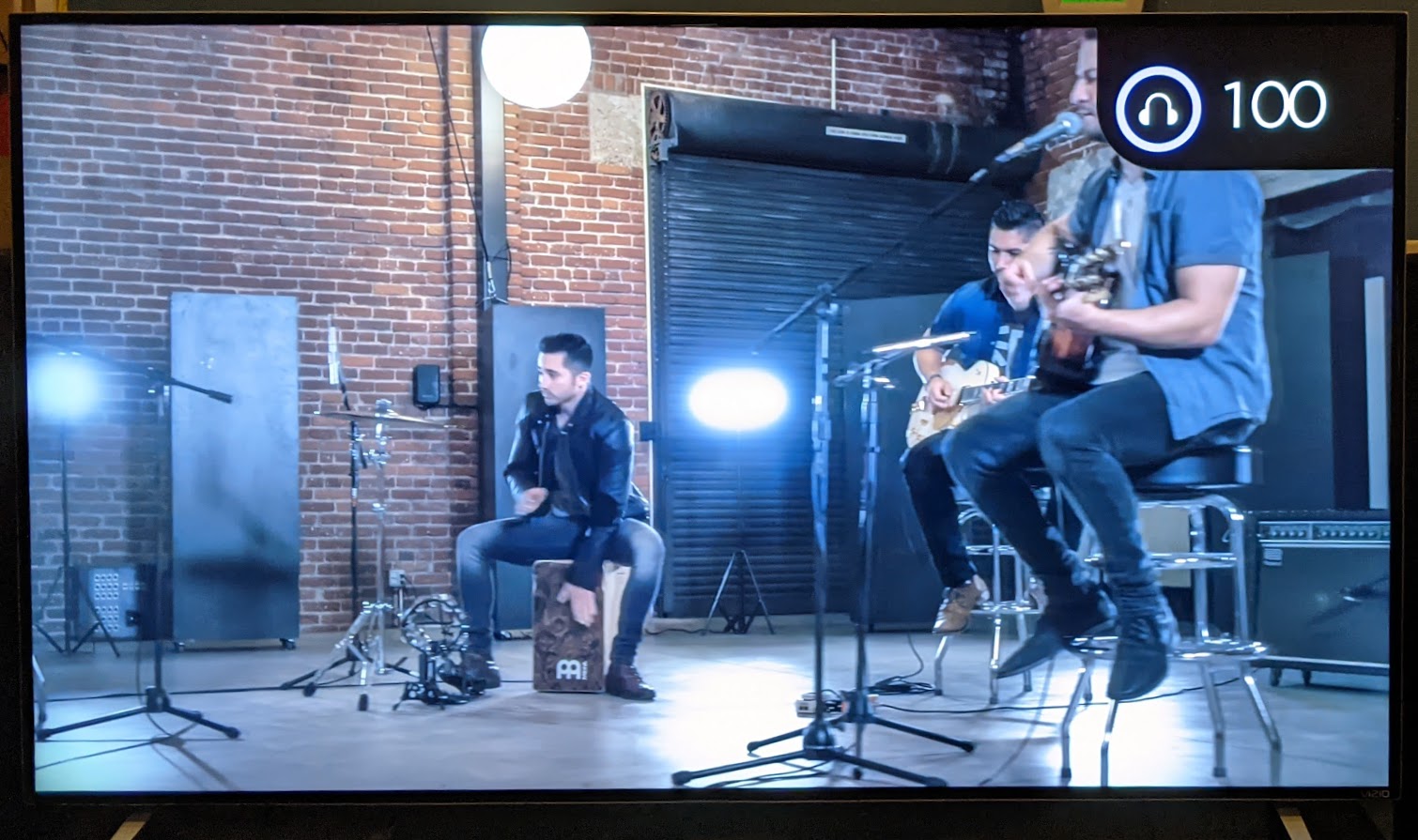 Increasing the Roku source volume all the way to maximum produced seriously unpleasant square-wave distortion, but it wasn't any louder than it had been at 85.Jim Salter
Increasing the Roku source volume all the way to maximum produced seriously unpleasant square-wave distortion, but it wasn't any louder than it had been at 85.Jim Salter I tested the Puro Pro volume-limiting safety feature, both wireless and wired. For the wired testing, I connected the Puro Pro to my Roku Premiere remote as shown here.Jim Salter
I tested the Puro Pro volume-limiting safety feature, both wireless and wired. For the wired testing, I connected the Puro Pro to my Roku Premiere remote as shown here.Jim Salter
The volume-limiting function on the Puro Pros is configurable; you can't turn it off, but you can switch it between 85dBA (default) or 95dBA by simultaneously pressing both volume buttons. (This is why I referred to the volume as a "faux rocker" earlier; the single wide cap makes it feel like a rocker switch, but unlike a true rocker switch, you can actually press both sides at once.)
I'm not set up to properly, scientifically test the volume-limiting feature of the Puro Pro. All I could do was carefully increase both source volume and headphone volume and see what happened. With the limiter set on its default 85dBA value, I would describe the max volume as "comfortably loud"—in other words, louder than I'd generally want a TV show but every bit as loud as I'd want an action movie or workout jam.
The 95dBA setting gets a little less comfortable but stops short of the kind of explosive AIIIIEEE! most of us have experienced from pressing "play" on a track that was louder than we expected.
Triggering the volume-limiting circuitry sounds terrible—in fact, it sounds exactly like overdriving an amplifier, producing ugly, ragged square-wave noises in your ears. The higher you turn the volume beyond the safety limit, the worse the square-wave distortion gets—but it doesn't actually get any louder.
Although the limiter sounds ugly, that wasn't a problem for me in normal use. I never audibly triggered it in a couple months of daily use of the headphones; I had to get experimental for review purposes to learn about it.
“I really don’t want it any louder”
After turning the volume up to "I really don't want it any louder than this," I took the phones off my ears and began slowly cranking the volume up, cautiously putting the phones back on my head in intervals. Once I was comfortable that the Puro Pros wouldn't actually hurt me (which all of my other, nonlimited headphones absolutely will), I began experimenting with scaling the volume up and down at very high levels while wearing the phones; apart from instinctive hate for the square-wave distortion, I didn't have any problems.
If my highly-calibrated Mark I eardrums aren't sufficient testing for you, you may be interested in Wirecutter's much more scientific October 2020 sound pressure limit testing, which I highly recommend for anybody who wants to deeply nerd out about this stuff. Wirecutter didn't test the Puro Pro model I'm reviewing here—but the site did test the kid-oriented Puro BT2200 phones (which presumably share similar if not identical technology), along with a dizzying array of competitors.
The folks at Wirecutter had access to an audio testing professional and about $8,000 worth of gear that I do not, and they went into extreme detail about how they tested and why. The short version: the Puro BT 2200 headphones were by far the most compliant with 85dBA safety limits, out of a very wide field tested. (The Wirecutter adults and Wirecutter kids unanimously picked the BT2200 as their overall top choice, too.)
One final note about the volume limiting: it's only guaranteed over Bluetooth connection. If you're using an audio cable and you're profoundly determined, you may be able to deafen yourself just fine, given a sufficiently powerful input source.
Audio quality—Bluetooth
At low volumes, the Puro Pro seems just a bit lacking in bass response—though at higher volumes, such as you would use for action movies or headbanging jams, the bass response picks up nicely, becoming perfectly sufficient without being boomy. The treble and midrange are clear and clean at any volume. The noise floor is low.
The only devices in my collection that match or near-match the Puro Pro's sound when connected wirelessly are the similarly-expensive JBL headphones and the Sennheiser Pro studio headphones (which need help with the "wireless" part since they're simple, wired phones; I tested them by connecting to the headphone jack on my Roku Premiere's remote, which tunnels audio over the remote's 2.4GHz Wi-Fi Direct connection.)
I tested the Puro Pro connected via wire to the Roku Premiere remote as well; I could not detect any significant difference in audio quality between the Roku remote's 2.4GHz Wi-Fi Direct link or the Boltune low-latency transceiver's Bluetooth 5.0 link.
Audio quality—wired
To pick up on any flaws the Puro Pro headphones actually have, I grabbed a cable and plugged the phones into a high-quality audio source: my Scarlett Solo preamp. Under those conditions, the Puro Pros still sounded great, with balanced response across the audio spectrum—but the sound was noticeably muddier than my reference Sennheiser HD 280 Pro studio headphones.
You will need something better than typical streaming sources to identify the difference. I spent a couple of hours obsessively listening to demanding sections of four tracks, alternating between the Sennheiser and Puro headphones. You can check those tracks out on this YouTube playlist, but you won't get the full effect there—the YouTube compression has a bigger effect in "muddying" the audio than either pair of phones.
When listening to FLAC or 320Kbps MP3 of Mick Gordon's "BFG Division" or Lorde's "Liability," tracks sounded noticeably crisper and with a more perceptible "soundstage" in the Sennheiser phones than on the Puro. By far the most audible difference was in the "drop" at approximately 1:02 in "BFG Division," which our own Sam Machkovech also used as a reference track in his review of the Pixel Buds 2.
Both Puro and Sennheiser did an excellent job with the high-pitched, glassy tinkling sound, but the Sennheiser produced a noticeably wider "sweeping" sense and feel of immersion as the bass dropped. Again, to really get the difference, you'll need a very high-quality audio source—there wasn't much difference between the two when listening to the segment on YouTube, but it was readily apparent when listening to a FLAC.
I perceived much less difference between the two sets of phones when listening to POS' "Bumper" and almost none when listening to Sarah Hyland's cover of "Closer" (which I only had access to via streaming media).
To make a long story short: if you're looking for an extremely high-quality set of wired, studio-reference headphones for use with semi-professional equipment and demanding, high bitrate, non-lossy sources... save yourself $100 and pick up the Sennheiser HD 280 Pro.
Ultimately, the Puro Pro is not a reference wired studio headphone set—but the fact that it's worth spending time and words comparing it to one is, in my opinion, pretty significant.
Battery life
The good people at Puro claim a battery life of 30+ hours on the Puro Pro, even with ANC enabled—and they're not kidding. I received these headphones in mid-December and used them for one to two hours per night for late-night TV watching. I did not need to recharge them until after my surgery on January 8.
Post-surgery, my entire day for two weeks was split between playing casual games on my tablet (which I did without headphones) or watching TV and movies (which I did with headphones on). With headphone time of eight to 10 hours per day, I only needed to recharge the Puro Pro headphones every three to four days.
Each time you power the phones on, the nice lady in your ear announces, "battery high," "battery middle," or "battery low" as appropriate. If she says "battery low," you can probably get through The Fellowship of the Ring without any issues, but you'll want to recharge before tackling The Two Towers.
Recharge time from completely empty to full takes about two hours.
Conclusion
At $200, the Puro Pro headphones certainly aren't inexpensive—but they're worth the price and well-suited to nearly any application. They are far and away the most comfortable headphones I've ever used, offer incredible battery life, have intuitive controls that are easy to operate by feel alone, and sound excellent. They also offer high quality Active Noise Cancellation and decent passive audio isolation from the over-the-ear cups.
While the audio quality of the Puro Pro isn't perfect, I had to break out a pair of wired-only Sennheiser HD 280 Pro reference phones connected to losslessly compressed audio delivered from a studio-grade preamp to really spot the difference. On the other end of a wireless connection—or a typical streaming media source, even if connected by wire—I couldn't spot enough difference between the two to talk about.
The Good
- Gentle clamping pressure, soft padding, and supple protein-leather covering on the cups make for comfortable listening, even for extended periods
- Battery life for—literally—days, with fast recharge time to boot
- Intuitive controls are easy to become familiar with and identify by touch alone
- Excellent audio quality—not quite up to reference-studio-headphone standards, but I needed reference-quality equipment and recordings to tell the difference
- Configurable 85/95dBA sound pressure level limiting for hearing safety
- Decent passive audio isolation, paired with excellent (optional) active noise cancellation
- Pleasantly delivered and functional spoken status indications for battery, connection, power, ANC, and SPL limiting
- Left and right cans clearly marked with large L and R inside the cup, where they're easy for the user to find but don't ugly up the outside
- Can be operated wired as well as Bluetooth 5.0
- Can be operated unpowered while wired, if you don't want the ANC enabled
- Comes with high-quality compact travel case, with netted internal section to hold (included) charge and audio cables
The Bad
- Charging is Micro USB-B, not USB-C—the "is it right side up?" fandango lives on
- SPL limiting not guaranteed when connected wired
The Ugly
- Having to worry about whether you have the charge cable right side up or not
- Buzzing artifact on staccato sounds at max headphone volume (Solution: turn headphone volume down a single click. Buzzing artifact gone)
Listing image by Jim Salter
https://ift.tt/3qQx8f0
Technology
Bagikan Berita Ini














0 Response to "$200 Puro Pro hybrid over-the-ear headphones are almost perfect - Ars Technica"
Posting Komentar